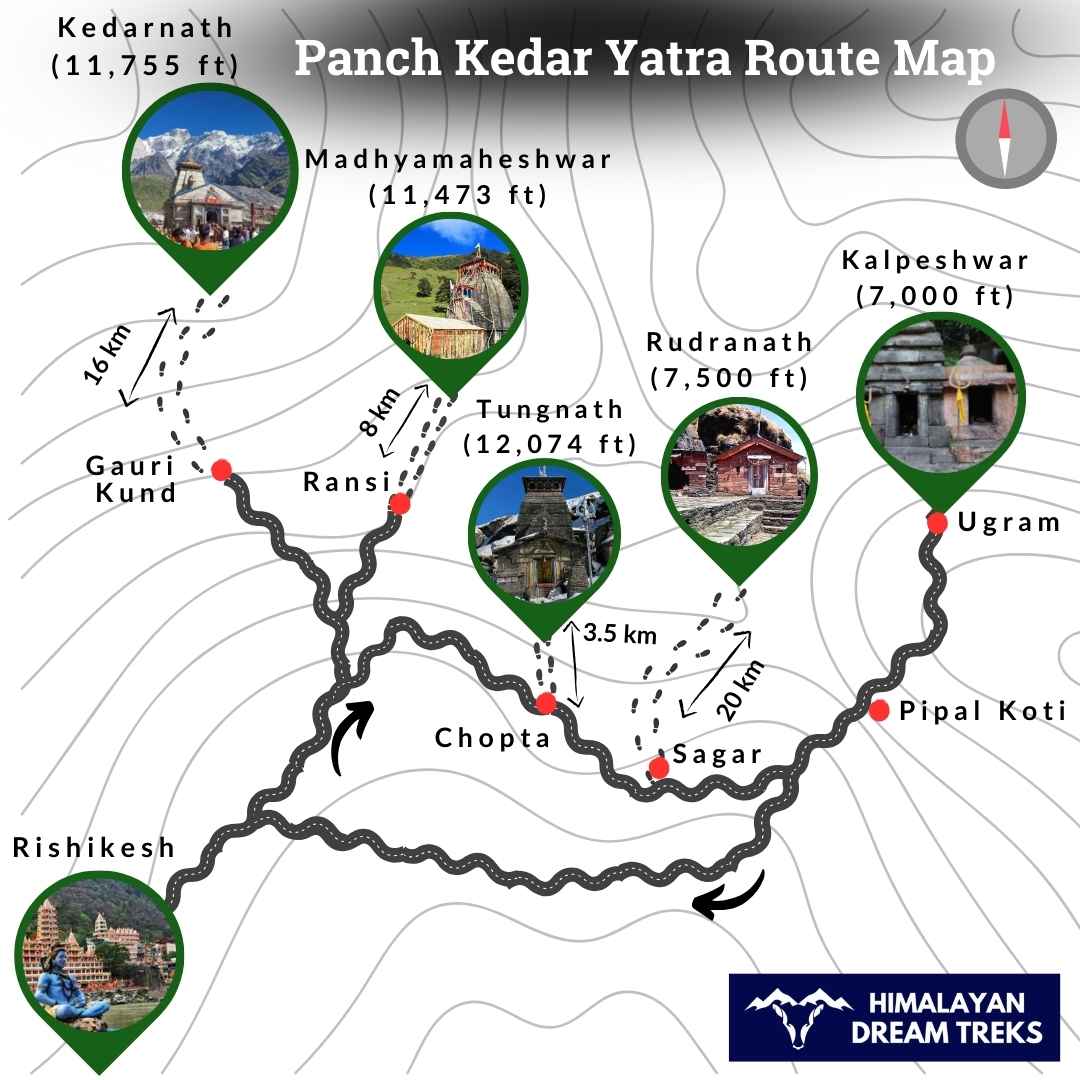
The Panch Kedar pilgrimage is a sacred journey to five revered Hindu temples dedicated to Lord Shiva. Nestled in the Garhwal Himalayas of Uttarakhand, these temples hold profound spiritual significance and are deeply intertwined with Hindu mythology. The temples included in the Panch Kedar circuit are Kedarnath, Madhyamaheshwar, Tungnath, Rudranath, and Kalpeshwar. Each shrine, associated with a unique part of Lord Shiva’s divine form, offers devotees a blend of spirituality, history, and breathtaking natural beauty.
Mythology and Origins of Panch Kedar
According to ancient legends, the origin of the Panch Kedar temples is linked to the Pandavas from the Mahabharata. Following the Kurukshetra war, the Pandavas sought Lord Shiva’s blessings to absolve their sins. However, Lord Shiva, displeased with the bloodshed, disguised himself as a bull and hid in the Himalayas. Bhima, one of the Pandavas, recognized the bull and tried to capture it. In response, Shiva disappeared into the earth, re-emerging at five different locations, each representing a distinct body part. These sites became the revered Panch Kedar temples, where the Pandavas built shrines to honor Shiva.
The Five Temples of Panch Kedar
1. Kedarnath Temple
- Significance: The most prominent of the Panch Kedar, representing Shiva’s hump.
- Location: Rudraprayag district, at an altitude of 3,583 meters.
- Trek: A 16 km trek from Gaurikund.
2. Madhyamaheshwar Temple
- Significance: Represents the navel of Lord Shiva.
- Location: Mansoona village, at 3,289 meters.
- Trek: A 16-19 km trek from Ransi Village.
3. Tungnath Temple
- Significance: The world’s highest Shiva temple, representing Shiva’s arms.
- Location: Near Chopta, at 3,680 meters.
- Trek: A 3.5 km trek from Chopta.
4. Rudranath Temple
- Significance: Dedicated to Shiva’s face, surrounded by dense forests.
- Location: Chamoli district, at 3,600 meters.
- Trek: An 18 km trek from Sagar Village or via Gopeshwar.
5. Kalpeshwar Temple
- Significance: Represents Shiva’s hair (Jata) and is the only temple accessible year-round.
- Location: Urgam Valley, at 2,200 meters.
- Trek: A 2-3 km trek from Helang.
Journey Highlights and Trekking Experience
The Panch Kedar Yatra spans approximately 95 kilometers and takes 11-12 days to complete. Starting from Rishikesh, the route weaves through awe-inspiring Himalayan landscapes, lush valleys, and serene villages. The journey is as much a test of physical endurance as it is a spiritual quest.
Typical Itinerary of the Yatra
Day 1: Drive from Rishikesh to Guptkashi.
Day 2: Guptkashi to Gaurikund and trek to Kedarnath.
Day 3: Descend to Gaurikund and drive back to Guptkashi.
Day 4: Drive to Ransi and trek to Gaundhar.
Day 5: Trek from Gaundhar to Madhyamaheshwar.
Day 6: Return to Ransi and drive to Ukhimath.
Day 7: Trek from Chopta to Tungnath and return.
Day 8-9: Trek to Rudranath via Sagar and Lyuti Bugyal.
Day 10: Return to Sagar Village and drive to Pipalkoti.
Day 11: Visit Kalpeshwar and return to Pipalkoti.
Day 12: Drive back to Rishikesh.
Notable Features of the Panch Kedar Pilgrimage
Kedarnath Temple: Integral to the Chota Char Dham Yatra and one of Shiva’s twelve Jyotirlingas.
Tungnath Temple: Renowned for being the highest Shiva temple worldwide.
Scenic Beauty: En route, pilgrims encounter panoramic views of snow-capped peaks, verdant meadows, and dense forests.
Mythological Significance: The Yatra symbolizes the Pandavas’ spiritual penance and their devotion to Lord Shiva.
Spiritual and Adventurous Appeal
The Panch Kedar Yatra is more than a pilgrimage; it’s a transformative experience. Devotees of all ages undertake this journey, drawn by the divine presence of Lord Shiva and the Himalayan wilderness. The trek’s challenges are rewarded with the serenity of the temples and the majesty of the surrounding landscapes.
Travel Tips and Recommendations
Sequence of Temples: The prescribed order is Kedarnath, Madhyamaheshwar, Tungnath, Rudranath, and Kalpeshwar.
Best Time to Visit: May to October, avoiding monsoon months due to landslide risks.
Preparation: Adequate fitness, warm clothing, and essentials for high-altitude trekking are necessary.
Read Blogs: One need to be well informed about travel and destination guides for a better experience.
Embarking on the Panch Kedar Yatra is a profound journey that combines spirituality, mythology, and adventure. Pilgrims return not just with memories of stunning vistas but with a deep sense of connection to Lord Shiva and the timeless serenity of the Himalayas.












